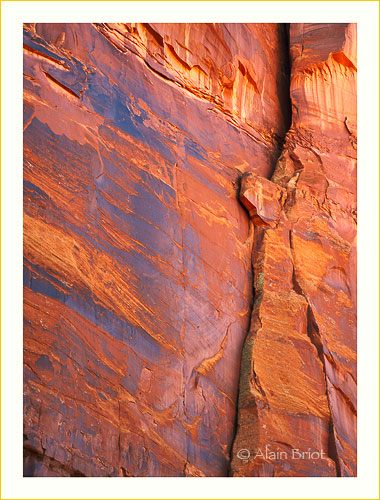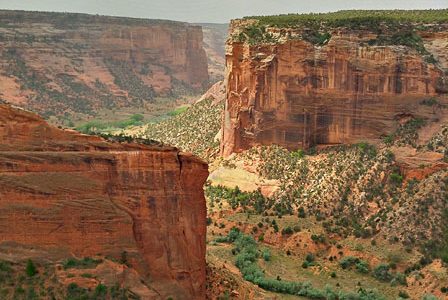

Introduction

Navajo Sandstone Wall
Photography is both an art and a science. Photography allows us to express our feeling and emotions, but to do so we need to master the scientific part of the medium. Unlike a painter, who is in direct contact with his subject and his canvas, a photographer is separated from his subject by the camera and from his “canvas” by computers and printers today and by darkroom equipment previously.
The scientific aspects of photography can be both overwhelming and fascinating, so much so that for some photographers photography comes to be just that: a scientific process that they attempt to master over their lifetime. However, to achieve mastery of the technical side of photography is to address only one of the two aspects of photography. The result is often technically excellent photographs that lack emotion and “seeing” qualities. In this regard, I share the opinion of Ansel Adams who said, and I paraphrase, that there is nothing more boring that a technically perfect rendering of a fuzzy visual concept. In other words, an artistic photograph is created when technique is used to express a vision and an emotion, not when technique is used for it’s own sake.
Countless articles are written daily about the many scientific aspects of photography. From equipment reviews, to image processing techniques, to tips on how to be a more efficient photographer, to stories about what works and what doesn’t, there is no shortage of material on the subject. Nothing wrong with that. In fact, I have contributed my share of articles on this subject and I will continue to do so. Again, the scientific aspect of photography is very important and learning as much as you can about it is certainly worth your time and efforts.
However, learning about the artistic aspect of photography is just as important. Unfortunately, there is a much lesser amount of information on photography as art. Far fewer essays are being written, far fewer discussions are taking place, and far less information, help and tips are available. It is as if photographers, for the most part, discovered how much they have to learn about photographic science and, overwhelmed and enchanted by equipment and technique, stopped there and looked no further. It may also be that some photographers, or photographic instructors, are uncomfortable writing about photography as art, or lack the practice and knowledge to do so.
The goal of this series is to remedy this situation in two ways: first, by providing you with a source of help and information about the artistic aspect of photography. Second, by making use of my personal background. I was trained as a painter and artist at theAcademie des Beaux Artsin Paris and later discovered photography. From day one I approached photography as an art form just as capable of expressing what I see and feel as any other artistic medium. My training, combined with my practice and knowledge of many artistic medium, provides me with a unique perspective on photography. For example, I often draw comparisons between photography and other arts. I also look at art from both a historical and a contemporary perspective. Finally, I make my living selling fine art prints, writing about photography and art, and teaching photography. In short, I am not just an observer. I am an active practitioner, writer, teacher and student of both aspects of photography. I am also an art collector, an enthusiastic admirer, and an occasional practioner of many other artistic medium.
When I decided to start this series I carefully considered what the contents of each essay might be. The last thing I wanted to do was provide ineffective, redundant or superficial information. I wanted to avoid what I perceived to be the most obvious pitfalls of such a series, namely to talk of photography as if it was art, without attempting to explain why it is, and later proceed to apply art concepts to photography, as if there was a direct crossover between photography and other arts.
At first I did not know how, or if, this could be done. It was only after writing and publishing on my site several essays for a series I originally titled Thoughts and Photographs that I felt confident to have found the proper format. I later renamed this series Reflections on Photography and Art, a title that I continue to find appropriate for this endeavor since this is after all a reflection, albeitedly one based on years of experience.
At this time I have a list of over 25 essays that I am considering including in this series. Certainly, some of these essays will be revised, while some will be pushed aside and new ones will be introduced. This list is but a beginning, a starting point. However, I feel more confident starting on this journey knowing that I can proceed further than a couple of essays. I feel better having a road map, so to speak, to guide me in the exploration of photography as art.
In comparison to my previous series,Photography and Aesthetics, this new series is written in a freer, more direct fashion.Photography and Aestheticsconsists of carefully organized articles written over weeks and, for the later articles in the series, months. Reflections on Photography and Artconsists of essays, a format that allows me a much freer approach to the content of each piece. As we will see in the series, feeling free to create is one of thesine qua nonconditions for practicing photography as art. I deemed it perfectly natural to metaphorically shape the structure of each essay around one of the overall premises for this series.
Do you want to build upon your current skills by studying the artistic aspect of photography? If your answer is yes, I welcome you to join me in what can only be an enlightening, though at times challenging, experience.
Alain

Lorem ipsum dolor sit amet, consectetur adipiscing elit, sed do eiusmod tempor incididunt ut labore et dolore magna aliqua. Ut enim ad minim veniam, quis nostrud exercitation ullamco laboris nisi ut aliquip ex ea commodo consequat. Duis aute irure dolor in reprehenderit in voluptate velit esse cillum dolore eu fugiat nulla pariatur. Excepteur sint occaecat cupidatat non proident, sunt in culpa qui officia deserunt mollit anim id est laborum.
Lorem ipsum dolor sit amet, consectetur adipiscing elit, sed do eiusmod tempor incididunt ut labore et dolore magna aliqua. Ut enim ad minim veniam, quis nostrud exercitation ullamco laboris nisi ut aliquip ex ea commodo consequat. Duis aute irure dolor in reprehenderit in voluptate velit esse cillum dolore eu fugiat nulla pariatur. Excepteur sint occaecat cupidatat non proident, sunt in culpa qui officia deserunt mollit anim id est laborum.
You May Also Enjoy...
Vision 13-Photographer’s Block
by Alain Briot The way to get out of photographer’s block is to simply place some constraints on yourself. Austin Kleon 1 - Introduction Expressing our
Red and Black Women
Please use your browser'sBACKbutton to return to the page that brought you here.

